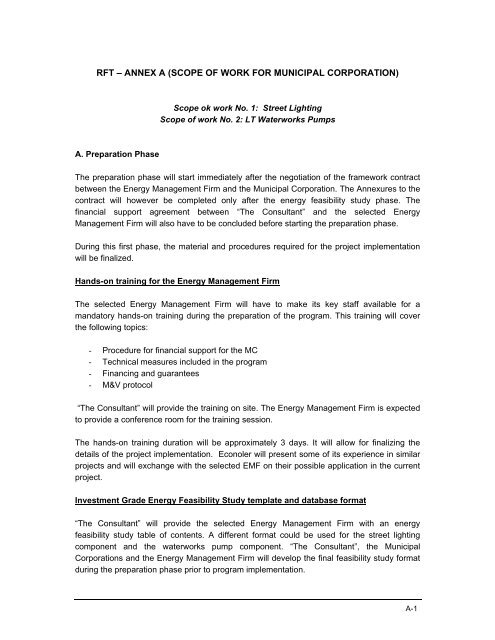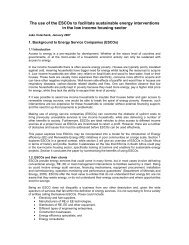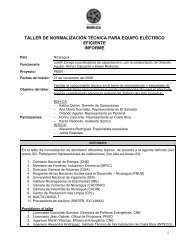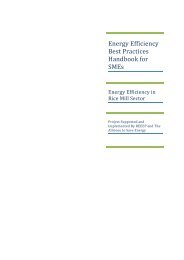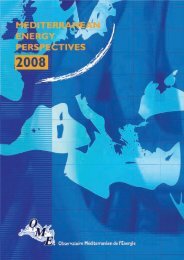scope of work for municipal corporation - REEEP Toolkits
scope of work for municipal corporation - REEEP Toolkits
scope of work for municipal corporation - REEEP Toolkits
You also want an ePaper? Increase the reach of your titles
YUMPU automatically turns print PDFs into web optimized ePapers that Google loves.
Once the <strong>for</strong>mat <strong>of</strong> the feasibility study will be finalized, the Energy Management Firm willprepare a database on MS Excel <strong>for</strong>mat that will be filled during program implementation <strong>for</strong>the summarization <strong>of</strong> energy feasibility study results and their transmission to DISCOM and“The Consultant”.B. Implementation PhaseThe implementation phase will begin when all material, procedures and tools requested <strong>for</strong>the program operation are put in place.Investment Grade Energy Feasibility StudyThe Baseline Energy Consumption and Demand shall be determined accordingly to theAnnexure A <strong>of</strong> the per<strong>for</strong>mance contract. This contract can be found in Annex E <strong>of</strong> thepresent RFT.Street lighting componentThe energy feasibility study will be per<strong>for</strong>med by the Energy Management Firm resourcesusing the report template created during the preparation phase. They will have to go on siteand fill <strong>for</strong>ms describing the system characteristics, including:- exact number <strong>of</strong> fixtures <strong>for</strong> each selected switching point- the type <strong>of</strong> lamps and ballasts- their theoretical capacity (W)- spacing between the posts- number <strong>of</strong> burned/ dis-functioning lamps- lighting levelSurveyA survey designed to determine the power <strong>for</strong> typical fixtures <strong>for</strong> lamps and ballasts and thelighting level (in lux) should be per<strong>for</strong>med by the Municipal Corporations. Annex B <strong>of</strong> the RFTincludes a table that describes the results from tests realized on typical fixtures <strong>for</strong> otherMunicipal Corporations. The same table must be per<strong>for</strong>med <strong>for</strong> [relevant MC to fill name]Municipal Corporation, with data appropriate to the survey. The Energy Management Firmcan use these data as typical ones <strong>for</strong> the preparation <strong>of</strong> its technical and financial <strong>of</strong>fer aswell as field visit observations or other data or estimates it can derive from its previousexperience. These data will have to be updated with additional field measurement to berealized by the Energy Management Firm during the energy feasibility study.For bidding purpose, the Energy Management Firm could use the following procedure toestimate the cost <strong>for</strong> the realization <strong>of</strong> these additional measurements. The EnergyManagement Firm should clearly indicate in its technical <strong>of</strong>fer if it intends to do additionaltests to guarantee the per<strong>for</strong>mance <strong>of</strong> the proposed measure or if it will only per<strong>for</strong>m theA-2
LT Water<strong>work</strong>s pumps componentThe energy feasibility study will be per<strong>for</strong>med by Energy Management Firm’s resourcesusing the report template created during the preparation phase. They will have to go on siteand fill a <strong>for</strong>m describing the system. The <strong>for</strong>m will be a 2-3 pages document describing thevarious system characteristics. Main data on equipment like foot valve, inlet pipe, pump,discharge pipe, date, water table height if possible will be collected.The Energy Management Firm will realize an efficiency test <strong>for</strong> the existing system during theaudit. The Energy Management Firm will be required to coordinate each feasibility study withthe MC’s, and DISCOM’s designated resources that will be present during the initial pumptest to confirm the readings and the initial efficiency <strong>of</strong> the system. An initial efficiency testreporting will be prepared and signed by the Energy Management Firm’s representative andthe MC’s and DISCOM’s representative.The efficiency test will be a short term test where the power input to the pump and the waterflow will be measured in order to determine an efficiency index in l/s per kW <strong>for</strong> the existingpumping system. The flow rate <strong>of</strong> the pumping system could be determine by a volumetrictest (filling a tank in a given time), a flow meter (ultrasonic, Doppler effect or mechanical fittedat the pump discharge) or by using a calibrated XY chart to measure the shape <strong>of</strong> the flowdischarge. The power should be measured by a three phase power meter when applicable.The in<strong>for</strong>mation collected during the test will constitute the baseline against witch theimproved efficiency after measure implementation will be compared to determine thesavings. The Energy Management Firm should clearly indicate in its bid which measurementmethod it intends to use to determine pumping system efficiency.The energy feasibility study will then be completed by including an evaluation per<strong>for</strong>med bythe Energy Management Firm <strong>of</strong> the expected improvement <strong>of</strong> the system if a more efficientpump and piping system components replace the existing unit.The following criteria must be met <strong>for</strong> a project to be acceptable <strong>for</strong> financial support by “TheConsultant”:- The expected improvement in pumping system efficiency index should be 25%.- The Energy Management Firm must consider a global improvement <strong>of</strong> the systemand not only focus on pump replacement.The cost <strong>of</strong> the measures will have been identified in the bid <strong>of</strong> the Energy Management Firmand should be confirmed after the energy audit.The results <strong>of</strong> the energy feasibility study will be presented in a written report prepared by theEnergy Management Firm in paper <strong>for</strong>mat to the MC and in electronic <strong>for</strong>mat to “TheConsultant”.Potential energy efficiency measures <strong>for</strong> the LT Water<strong>work</strong>s pumpsThe improvements could consist in:A-4
• replacement <strong>of</strong> small low efficiency pumps (5-10hp) by new high efficiency pumps• improvement <strong>of</strong> the pumping systems- installation <strong>of</strong> strainer and foot valve- replacement <strong>of</strong> piping by new reduced friction piping- optimization <strong>of</strong> fittings, valves• replacement <strong>of</strong> a fewer number <strong>of</strong> larger pumps (15hp) by new high efficiency pumpsContract finalizationThe contract annexures will be finalized after the detailed energy feasibility study based onthe template presented in Appendix F <strong>of</strong> the RFT. The updated annexures will be signed bythe MC and the Energy Management Firm.“The Consultant” and the MC will <strong>of</strong>ficially confirm that the proposed project is acceptable tothe program.Savings shall be calculated according to the methodology described in Annexure A <strong>of</strong> theper<strong>for</strong>mance contract.Financing arrangementThe Energy Management Firm should provide the financing <strong>for</strong> the realization <strong>of</strong> the project.IREDA is one <strong>of</strong> the organizations involved in the project implementation and is interested toprovide financing to interested party. However, the securing <strong>of</strong> financing through IREDA isnot a prerequisite <strong>for</strong> submitting a proposal on this project. The Energy Management Firm isfree to use another financing source.Equipment installationThe Energy Management Firm will proceed with the implementation <strong>of</strong> the new fixtures andcontrol systems on the street lighting net<strong>work</strong>.The Energy Management Firm will also proceed with the implementation <strong>of</strong> the new, smallersize and/or better efficiency pump and the improvement <strong>of</strong> the piping system and fitting. Thepump system rectification could include the foot valve replacement, new inlet piping <strong>of</strong>optimized size or smoother material, new pump and new discharge piping. When thecommissioning is completed satisfactory, the Energy Management Firm will notify “TheConsultant”.The equipment replaced should be removed, dismantled and either remitted to the City orscrapped by the Energy Management Firm in an environmentally sound way. The EMFshould take appropriate caution when removing ballasts as they may contain toxic materialthat could need special handling or disposal methods. The Energy Management Firm shouldensure that the used lamps, ballast, fixtures or pumps could not be reintroduced in themarket and a pro<strong>of</strong> <strong>of</strong> environment friendly disposal <strong>of</strong> the material will need to be submittedto the DSM Cells <strong>of</strong> Central, East or West DISCOM.A-5
Measurement and verification <strong>of</strong> energy efficiency improvementOnce “The Consultant” had been notified <strong>of</strong> the completion <strong>of</strong> the project, a measurementand verification visit will be planned. This visit will have the MC representative, DISCOM andthe Energy Management Firm. The draft per<strong>for</strong>mance contract can be found as Annex E <strong>of</strong>the present RFT.The final calculated value <strong>of</strong> energy savings will then be used to determine the monthlyamount that the MC will reimburse to the Energy Management Firm. The financial support by“The Consultant” will not be affected by the per<strong>for</strong>mance guarantee provided to the MC.The measurement done after the improvement and the percentage <strong>of</strong> improvement will beindicated in a report that will be signed by the MC’s representative, the DISCOM’srepresentative and the Energy Management Firm.Annual M&V process to determine the energy savingsOnce a year at the anniversary date <strong>of</strong> the commencement date (beginning <strong>of</strong> the PaybackPeriod) a measurement and verification <strong>of</strong> the savings will be per<strong>for</strong>med to determine thelevel <strong>of</strong> savings that will be used <strong>for</strong> the following year. The approach will be similar to theone described above.Street lighting componentA short-term measurement campaign will be per<strong>for</strong>med at the beginning <strong>of</strong> each subsequentyear in the Payback Period to determine a revised savings level <strong>for</strong> the year.LT Water<strong>work</strong>s pumps componentA short-term measurement campaign will be per<strong>for</strong>med at the beginning <strong>of</strong> each subsequentyear in the Payback Period to determine a revised savings level <strong>for</strong> the year. Theimprovement will be measured as a percentage improvement in the energy efficiency index<strong>of</strong> the pumping system.A-6


